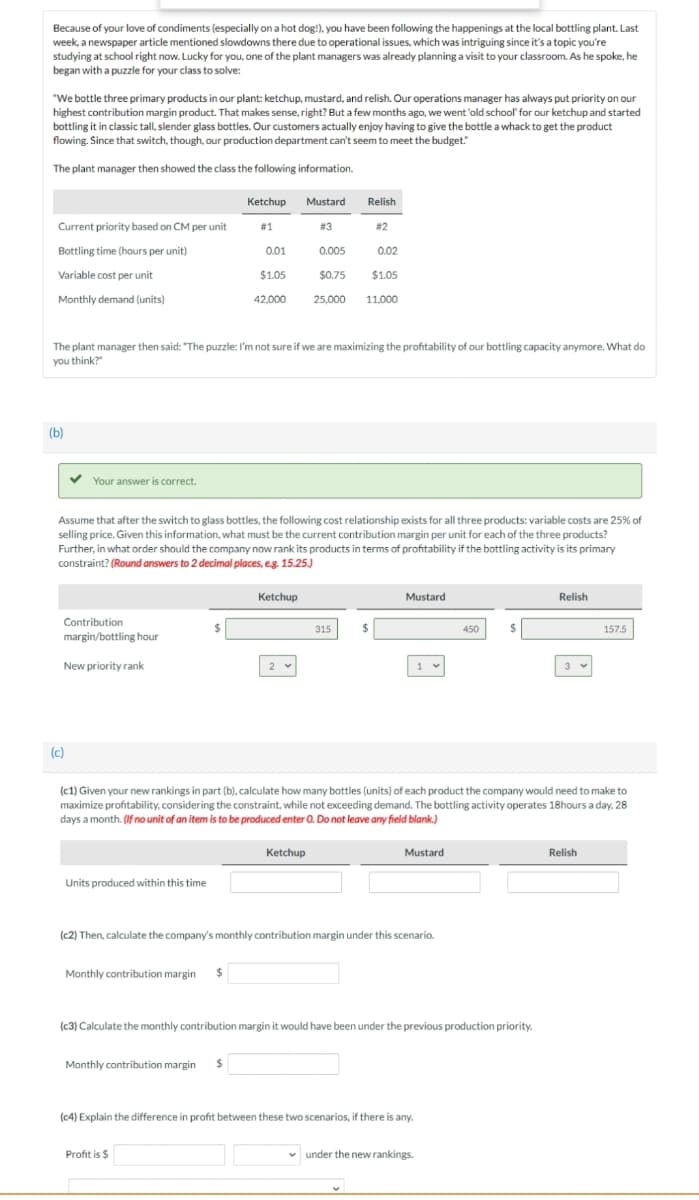(c) (c1) Given your new rankings in part (b), calculate how many bottles (units) of each product the company would need to make to maximize profitability, considering the constraint, while not exceeding demand. The bottling activity operates 18hours a day, 28 days a month. (If no unit of an item is to be produced enter 0. Do not leave any field blank.) Ketchup Mustard Relish Units produced within this time (c2) Then, calculate the company's monthly contribution margin under this scenario. Monthly contribution margin $ (c3) Calculate the monthly contribution margin it would have been under the previous production priority. Monthly contribution margin $ (c4) Explain the difference in profit between these two scenarios, if there is any. Profit is $ under the new rankings.
(c) (c1) Given your new rankings in part (b), calculate how many bottles (units) of each product the company would need to make to maximize profitability, considering the constraint, while not exceeding demand. The bottling activity operates 18hours a day, 28 days a month. (If no unit of an item is to be produced enter 0. Do not leave any field blank.) Ketchup Mustard Relish Units produced within this time (c2) Then, calculate the company's monthly contribution margin under this scenario. Monthly contribution margin $ (c3) Calculate the monthly contribution margin it would have been under the previous production priority. Monthly contribution margin $ (c4) Explain the difference in profit between these two scenarios, if there is any. Profit is $ under the new rankings.
Chapter1: Financial Statements And Business Decisions
Section: Chapter Questions
Problem 1Q
Related questions
Question
Please help me

Transcribed Image Text:Because of your love of condiments (especially on a hot dog!), you have been following the happenings at the local bottling plant. Last
week, a newspaper article mentioned slowdowns there due to operational issues, which was intriguing since it's a topic you're
studying at school right now. Lucky for you, one of the plant managers was already planning a visit to your classroom. As he spoke, he
began with a puzzle for your class to solve:
"We bottle three primary products in our plant: ketchup, mustard, and relish. Our operations manager has always put priority on our
highest contribution margin product. That makes sense, right? But a few months ago, we went 'old school' for our ketchup and started
bottling it in classic tall, slender glass bottles. Our customers actually enjoy having to give the bottle a whack to get the product
flowing. Since that switch, though, our production department can't seem to meet the budget."
The plant manager then showed the class the following information.
Ketchup Mustard
Relish
Current priority based on CM per unit
# 1
# 3
# 2
Bottling time (hours per unit)
0.01
0.005
0.02
Variable cost per unit
$1.05
$0.75
$1.05
Monthly demand (units)
42,000
25,000 11,000
The plant manager then said: "The puzzle: I'm not sure if we are maximizing the profitability of our bottling capacity anymore. What do
you think?"
(b)
Your answer is correct.
Assume that after the switch to glass bottles, the following cost relationship exists for all three products: variable costs are 25% of
selling price. Given this information, what must be the current contribution margin per unit for each of the three products?
Further, in what order should the company now rank its products in terms of profitability if the bottling activity is its primary
constraint? (Round answers to 2 decimal places, eg. 15.25.)
Ketchup
Mustard
Relish
Contribution
315
450
157.5
margin/bottling hour
New priority rank
2
(c)
(c1) Given your new rankings in part (b), calculate how many bottles (units) of each product the company would need to make to
maximize profitability, considering the constraint, while not exceeding demand. The bottling activity operates 18hours a day, 28
days a month. (If no unit of an item is to be produced enter 0. Do not leave any field blank.)
Ketchup
Mustard
Relish
Units produced within this time
(c2) Then, calculate the company's monthly contribution margin under this scenario.
Monthly contribution margin $
(c3) Calculate the monthly contribution margin it would have been under the previous production priority.
Monthly contribution margin
$4
(c4) Explain the difference in profit between these two scenarios, if there is any.
Profit is $
under the new rankings.
Expert Solution
This question has been solved!
Explore an expertly crafted, step-by-step solution for a thorough understanding of key concepts.
This is a popular solution!
Trending now
This is a popular solution!
Step by step
Solved in 5 steps

Knowledge Booster
Learn more about
Need a deep-dive on the concept behind this application? Look no further. Learn more about this topic, accounting and related others by exploring similar questions and additional content below.Recommended textbooks for you


Accounting
Accounting
ISBN:
9781337272094
Author:
WARREN, Carl S., Reeve, James M., Duchac, Jonathan E.
Publisher:
Cengage Learning,

Accounting Information Systems
Accounting
ISBN:
9781337619202
Author:
Hall, James A.
Publisher:
Cengage Learning,


Accounting
Accounting
ISBN:
9781337272094
Author:
WARREN, Carl S., Reeve, James M., Duchac, Jonathan E.
Publisher:
Cengage Learning,

Accounting Information Systems
Accounting
ISBN:
9781337619202
Author:
Hall, James A.
Publisher:
Cengage Learning,

Horngren's Cost Accounting: A Managerial Emphasis…
Accounting
ISBN:
9780134475585
Author:
Srikant M. Datar, Madhav V. Rajan
Publisher:
PEARSON

Intermediate Accounting
Accounting
ISBN:
9781259722660
Author:
J. David Spiceland, Mark W. Nelson, Wayne M Thomas
Publisher:
McGraw-Hill Education

Financial and Managerial Accounting
Accounting
ISBN:
9781259726705
Author:
John J Wild, Ken W. Shaw, Barbara Chiappetta Fundamental Accounting Principles
Publisher:
McGraw-Hill Education